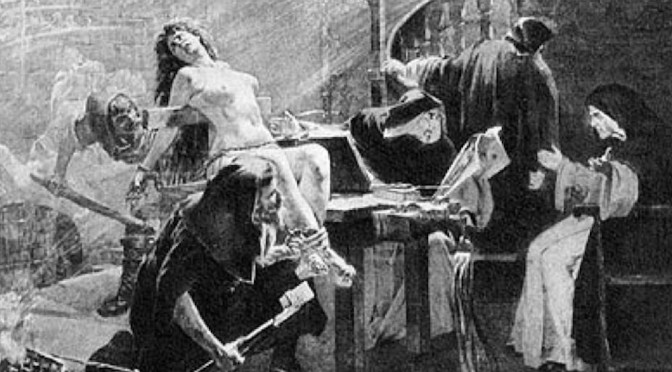The Holy Inquisition came in the footsteps of the crusade, designed and utilised to totally eradicate the Cathar Religion and humilate and terrify the people of Occitan. During Ximene’s teenage years it was still is having a frightful outcome; friends betray friends, brothers betray sisters, children betray parents, servants betray masters, all in an attempt to avoid their own interrogation, torture and death.
The last perfect
In 1321 Guillaume Belibaste ‘The last Perfect’ was burned to death tied to a stake in the town square of Villerouge Termenes in the Corbiers.
There were over five hundred recorded instances in the previous hundred years, in practice there were probably far more. Burning at the stake though horrific and deliberately public, is not the only torture a victim of the inquisition might face.
When in 1431 the English and Burgundians burnt Joan of Arc, a feature of the prosecution case at the trial was that Joan had not been tortured or abused whilst in captivity. For this to be significant, it must mean that for others accused of heresy it was commonplace.
Before 1300 burnings without trial were not uncommon but from 1300 onwards the emphasis turned towards interrogation and torture supposedly to save souls.
Torture then Death
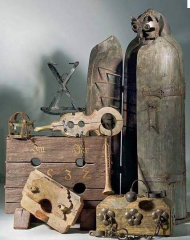 Thus blinding a person guilty of reading heretical literature, so that no more reading was possible, or ripping the tongue out of a heretical teacher so no more sermons were possible, were both considered necessary for the salvation of souls.
Thus blinding a person guilty of reading heretical literature, so that no more reading was possible, or ripping the tongue out of a heretical teacher so no more sermons were possible, were both considered necessary for the salvation of souls.
From 1300 the inquisition was in theory not allowed to kill anyone, though “accidents” during interrogation could and did happen. A cursory examination of the instruments of torture make it surprising that there were not many deaths during interrogation. When the inquisition was finished with torture or where they felt their victim was so high profile that the effects of torture would attract attention, the victim would be handed over to the secular authority for execution.
For heretics the execution was almost always carried out by burning at the stake. These executions performed a dual function. They disposed of an opponent who was considered a threat and when presented as a public spectacle acted as a powerful deterrent to those who might have sympathy with the heretical faith.
St Dominic
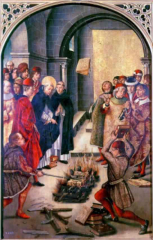 These diabolic practices originated at the beginning of the Albigensian crusade when Dominengo de Guzman, a son of Spanish nobility, attempted to win the support of the Cathar faithful and redirect them to the Church of Rome. He was rejected by the Cathars and he never forgave them for that. Guzman or (St Dominic to the Church of Rome ) invented the procedures for the Inquisition and it was the order of priests he founded which enacted the procedures.
These diabolic practices originated at the beginning of the Albigensian crusade when Dominengo de Guzman, a son of Spanish nobility, attempted to win the support of the Cathar faithful and redirect them to the Church of Rome. He was rejected by the Cathars and he never forgave them for that. Guzman or (St Dominic to the Church of Rome ) invented the procedures for the Inquisition and it was the order of priests he founded which enacted the procedures.
Guzman decided that his trappings of wealth repelled rather than impressed Cathars and toured Occitan barefoot and dressed in the plainest robes. He debated his beliefs and convictions with the Cathar faithful who talked openly about their version of Christianity. At Fanjeaux Dominengo’s notes were tossed into a fire by a Cathar supporter. The paper floated upwards out of the fire, one of the miracles recognised in his later beatification.
Hatred
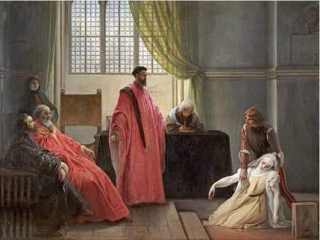 During these debates he learned to hate the Cathars on a personal level, because of their opposition, but he also learned everything about their strengths and weaknesses. Both would influence the formation of the Holy Inquisition and its techniques of interrogation.
During these debates he learned to hate the Cathars on a personal level, because of their opposition, but he also learned everything about their strengths and weaknesses. Both would influence the formation of the Holy Inquisition and its techniques of interrogation.
It was the start of a three hundred year campaign to ridicule Cathar teaching and to intimidate and denegrate its adherents. The centrepiece of this extended campaign was the Albigensian Crusade. Simply slaughtering large numbers of people and stealing their lands was not enough however, the Cathar religion had to be completely destroyed.
Dominengo plotted his revenge and gave his successors their instructions. On the very day he was beatified as St Dominic, the inquisition started its work in Occitan.
In 1233 the first Dominican inquisitors were appointed in Toulouse , Albi, Carcassonne and Narbonne, the heart of Occitan. The first act of the new order was to deceive a dying woman in Toulouse into confessing her heresy on her death bed, she was condemned as a heretic and burned, still in her bed, though she had only hours to live .
Unlimited power
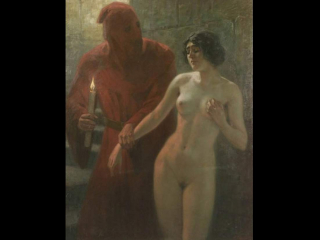 The first stage of the inquisition, accompanying the preliminary questioning is the removal of clothes and the display and demonstration to the prisoner of what could be inflicted on them.The Holy Inquistion had powers of arrest and incarceration without trial. The format of the inquisition was to ask a whole series of inconsequential questions about beliefs, family, neighbours or recent events. The process of intimidation included stripping those under interrogation of all their clothes. This was an integral part of Guzman’s plan, to make those questioned feel vulnerable.
The first stage of the inquisition, accompanying the preliminary questioning is the removal of clothes and the display and demonstration to the prisoner of what could be inflicted on them.The Holy Inquistion had powers of arrest and incarceration without trial. The format of the inquisition was to ask a whole series of inconsequential questions about beliefs, family, neighbours or recent events. The process of intimidation included stripping those under interrogation of all their clothes. This was an integral part of Guzman’s plan, to make those questioned feel vulnerable.
Whilst these initial questions are being answered the instruments of torture were displayed and demonstrated to the prisoner.
Heretics and non believers were allowed to recant or convert in return for information about friends family and acquaintances, but it was a last chance. If a lapse then was identified there were no limits to the torture which might be applied.
Democracy
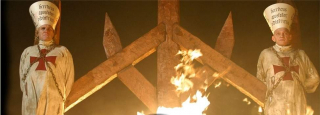 The Holy inquisition was very democratic, It affected the lives of everyone from aristocracy to the peasantry. However, if there was a general trend it was that those who have influence on the broader community were over represented in those interrogated. This can be explained by the fact that the Inquisition was being used as another phase of the Genocide initiated during the crusade or that it is being used as a tool to remove political opponents by those unscrupulous enough to use it that way.
The Holy inquisition was very democratic, It affected the lives of everyone from aristocracy to the peasantry. However, if there was a general trend it was that those who have influence on the broader community were over represented in those interrogated. This can be explained by the fact that the Inquisition was being used as another phase of the Genocide initiated during the crusade or that it is being used as a tool to remove political opponents by those unscrupulous enough to use it that way.
The members of the inquisition checked the initial answers for political and theological correctness and compared them with records of interrogation of other prisoners.The inquisitors were allowed to conceal their identity as many of those administering the torture are members of the local community.
The process
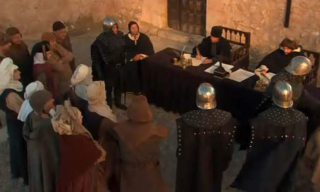 The Cathars beliefs were used against them.
The Cathars beliefs were used against them.
Victims of the inquisition were asked to swear their innocence on a bible “in the name of God”.
Cathars would not use the name of God in any material contract or oath and therefore it is expected that they would betray themselves at this stage.
Their hatred of the sacraments of the Roman Church was also used. People living together but who have not been married in a church ceremony were regarded as heretics.
On the other hand, in Occitan, proof of taking part in a christian marriage was regarded as proof of innocence, unless there is contrary proof that since the marriage they have lapsed into heretic ways. Obviously Cathars learned to make use of this.
The objective is to make the victim confess and then relinquish their heretic faith. If they do so they would be released but expected to assist the inquisition in pursuing other heretics. Failure to assist would then be regarded as a relapse and expose the poor unfortunate to further torture.
Escape
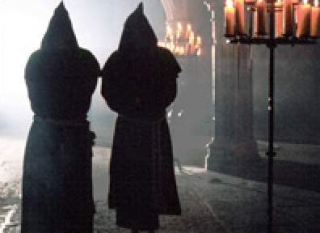 One alternative was flight to somewhere outside the control of the Church of Rome.
One alternative was flight to somewhere outside the control of the Church of Rome.Many fled to Mohammedan countries, but England is also favoured, as the English rulers had never allowed church courts the power they had elsewhere. Such a flight required wealth and assistance to avoid detection, particularly in the early part of the journey. Secret societies were formed whose main function was to assist Cathars escape the Inquisition’s net. The most succesful of these is “The Stars of the Sea” also known as “The Shining”. Like all secret societies the secrecy was maintained by a organisation where the members did not know each others identity or that of the leader and always met in public places.
Instruments of torture
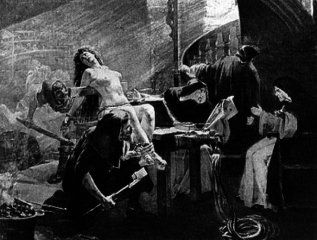 Pins are then stuck into every part of victims body. The excuse for this is that heretics with satanic powers are supposed to have areas of their body where they can feel no pain. The inquisitors claim that they are searching for such areas! From this point onwards some form of bondage was used to immobilise the victim. The bondage itself is used as a form of torture.
In its persecution of Cathars the inquisition targets women in particular. Many women are Cathar Perfects. Other Women host Cathar ceremonies.
One of the first tortures applied is the gripping of sensitive areas with red hot tongs. Nipples and the clitoris are favoured targets.The apologists for the Holy Inquisition claim that torture was rarely used. In fact Pope Gregory IX specifically sanctioned the use of toture. The existance of a wide range of instruments of torture in museums across the length and depth of Europe would suggest that torture was commonplace.
Pins are then stuck into every part of victims body. The excuse for this is that heretics with satanic powers are supposed to have areas of their body where they can feel no pain. The inquisitors claim that they are searching for such areas! From this point onwards some form of bondage was used to immobilise the victim. The bondage itself is used as a form of torture.
In its persecution of Cathars the inquisition targets women in particular. Many women are Cathar Perfects. Other Women host Cathar ceremonies.
One of the first tortures applied is the gripping of sensitive areas with red hot tongs. Nipples and the clitoris are favoured targets.The apologists for the Holy Inquisition claim that torture was rarely used. In fact Pope Gregory IX specifically sanctioned the use of toture. The existance of a wide range of instruments of torture in museums across the length and depth of Europe would suggest that torture was commonplace.
There was a great variety of instruments used.
Some were relatively crude but others showed great craftsmanship. Someone was proud of the products of their labour!
Those who succeded in escape and flight from the Inquisition made a record of the horrors they had seen.
Incredibly many of the devices used as instruments of torture were still in existance in the 1850′s when they were donated to museums.
The first stage of the inquisition, accompanying the preliminary questioning was the removal of clothes and the display and demonstration to the prisoner of what could be inflicted on them.
Pins were then stuck into every part of victims body. The excuse for this was that heretics with satanic powers are supposed to have areas of their body where they can feel no pain. The inquisitors claimed that they are searching for such areas! This painful procedure made it necessary to use some form of bondage to immobilise the victim.
The bondage itself is used as a form of torture. In its persecution of Cathars the inquisition targeted women in particular. Many women were Cathar Perfects. Other Women hosted Cathar ceremonies. One of the first tortures applied was the gripping of sensitive areas with red hot tongs. Nipples and the clitoris were favoured targets.
The chair
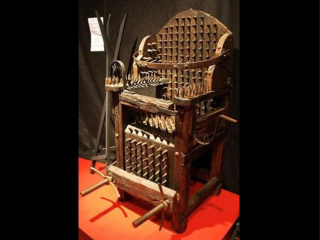 The victim can be constrained in several different ways in the chair. The spikes are designed to bruise but not penetrate the flesh. Placing women upside down in this chair leaves their clitoris and vagina open to attack. Similar treatment for men exposes their penis and testes.The victim could be constrained in several different ways in “the chair”. The spikes are designed to bruise but not penetrate the flesh. Placing women upside down in this chair left their clitoris and vagina open to attack. Similar treatment for men exposed their penis and testes.
The victim can be constrained in several different ways in the chair. The spikes are designed to bruise but not penetrate the flesh. Placing women upside down in this chair leaves their clitoris and vagina open to attack. Similar treatment for men exposes their penis and testes.The victim could be constrained in several different ways in “the chair”. The spikes are designed to bruise but not penetrate the flesh. Placing women upside down in this chair left their clitoris and vagina open to attack. Similar treatment for men exposed their penis and testes.
Dislocation
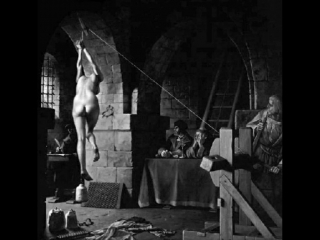 The simplest but very effective torture is to tie the victims hands behind their back and hoist them from the floor by the wrists. This usually results in the irreparable dislocation of both shoulders.The simplest but very effective torture was to tie the victims hands behind their back and hoist them from the floor by the wrists. this usually resulted in the irreparable dislocation of both shoulders.
The simplest but very effective torture is to tie the victims hands behind their back and hoist them from the floor by the wrists. This usually results in the irreparable dislocation of both shoulders.The simplest but very effective torture was to tie the victims hands behind their back and hoist them from the floor by the wrists. this usually resulted in the irreparable dislocation of both shoulders.
Judas Cradle
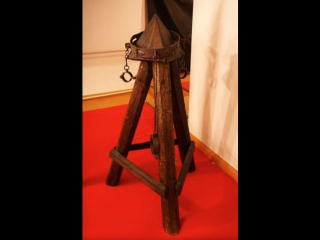 The Judas Cradle was the pointed end of a vertical pole, somewhat Innoculous at first glance until it is appreciated how it is used.The Judas Cradle was the pointed end of a vertical pole, somewhat innoculous at first glance until it is appreciated how it is used.
The Judas Cradle was the pointed end of a vertical pole, somewhat Innoculous at first glance until it is appreciated how it is used.The Judas Cradle was the pointed end of a vertical pole, somewhat innoculous at first glance until it is appreciated how it is used.
The Cradle was popular as although it inflicted excruciating agony (the point on which the person was lowered could be adjusted) it left no visible evidence of what had been done.
The mask
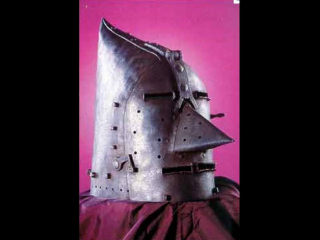 Masks and body enclosures were used so that longer pins could be inserted through holes in these devices at a later stage of the interrogation.
Alternatively the mask was heated before being clamped to the person's head. This resulted in the the victim loosing facial skin and eyeballs.Masks and body enclosures were used so that longer pins could be inserted through holes in these devices. Alternatively the mask was heated before being clamped to the person’s head. This resulted in the the victim loosing facial skin and often their eyeballs.
Masks and body enclosures were used so that longer pins could be inserted through holes in these devices at a later stage of the interrogation.
Alternatively the mask was heated before being clamped to the person's head. This resulted in the the victim loosing facial skin and eyeballs.Masks and body enclosures were used so that longer pins could be inserted through holes in these devices. Alternatively the mask was heated before being clamped to the person’s head. This resulted in the the victim loosing facial skin and often their eyeballs.
The pear
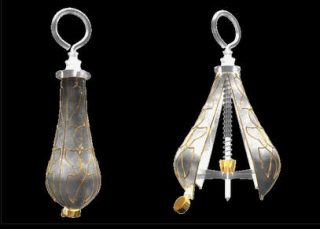 Most horrific was the ”Pear” this device could be inserted into the vagina , anus or throat and be activated by an external screw. it would tear sensitive flesh to pieces. There are many examples of the “Pear” in museums. They were obviously, for inquisitors, treasured possessions. Look at the use of artwork to beautify these abominable devices.Most horrific was the ”Pear” this device could be inserted into the vagina , anus or throat and be activated by an external screw. It would tear sensitive flesh to pieces. There are many examples of the “Pear” in museums. They were obviously, for inquisitors, treasured possessions. Look at the use of artwork to beautify these abominable devices.
Most horrific was the ”Pear” this device could be inserted into the vagina , anus or throat and be activated by an external screw. it would tear sensitive flesh to pieces. There are many examples of the “Pear” in museums. They were obviously, for inquisitors, treasured possessions. Look at the use of artwork to beautify these abominable devices.Most horrific was the ”Pear” this device could be inserted into the vagina , anus or throat and be activated by an external screw. It would tear sensitive flesh to pieces. There are many examples of the “Pear” in museums. They were obviously, for inquisitors, treasured possessions. Look at the use of artwork to beautify these abominable devices.
Jaques Fournier
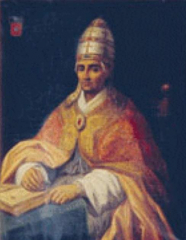 Jaques Fournier, Bishop of Palmiers took personal responsibility for the activities of the Inquistion in his bishopric. The execution of Guilliaume Belibaste was specifically his initiative. His claim to have eradicated the last vestiges of the Cathar Faith was the reason he was elected as Pope Benedict XII in 1334.
Jaques Fournier, Bishop of Palmiers took personal responsibility for the activities of the Inquistion in his bishopric. The execution of Guilliaume Belibaste was specifically his initiative. His claim to have eradicated the last vestiges of the Cathar Faith was the reason he was elected as Pope Benedict XII in 1334.
He was born close to Foix, possibly at Saverdun. After education in Paris he was appointed to Palmiers deep in Cathar country in 1317. The Dominicans were nominally responsible for the inquisition but Fournier was very proud of their achievements. It is known that there were deaths during interrogations and burnings of heretics during his tenure.
Jaques Fournier funded a two year long campaign to lure Guilliame Belabeste “The last remaining Perfect” from a safe haven in Aragon to Foix, where he was arrested, tortured and subsequently burnt at the stake in Termenes, his place of birth. Every aspect of his execution including dragging him from Carcassonne, where he was interrogated, to Termenes where he was executed, was choreographed to denigrate his beliefs and to horrify and intimidate the general population.
On his appointment as Pope, he took with him to Avignon the entire library of records of nine years of interrogations. They are still there in the Vatican library in Rome. It was Pope Benedict who in 1338 , horrified by the news of the birth of Ximene Trencavel and the potential re-emergence of the Cathar faith called her “The most dangerous woman in the world”
Montaillou
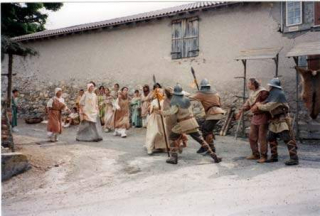 In 1318 Jaques Fournier organised a raid against the remote pyrenean village of Montaillou. It was not the only raid of its type but it is the best documented. The records of the Inquisition have been studied by Emmanuel Le Roy Ladurie and the results published in his book, Montaillou: The Promised Land of Error. Translated by Barbara Bray. New York: G. Braziller, c1978.
In 1318 Jaques Fournier organised a raid against the remote pyrenean village of Montaillou. It was not the only raid of its type but it is the best documented. The records of the Inquisition have been studied by Emmanuel Le Roy Ladurie and the results published in his book, Montaillou: The Promised Land of Error. Translated by Barbara Bray. New York: G. Braziller, c1978.
The raid was planned well. It was not carried out by an army for there were no armies to fight. There were a small number of mounted soldiers to provide some strike capability but by far the biggest proportion of the force sent to Montaillou were foot soldiers. Soldiers is perhaps the wrong word. They were a collection of citizens who could not refuse a demand by the church to provide service. Robbers, murderers, rapists, usurers, bankrupts or relenting heretics were all summonsed for duty.
There were enough of them to put a cordon around the entire village and then move inwards, tightening their grip until everyone living in the village was in captivity. Then the inquisition commenced.
Ximene’s grandmother Eleanor de Pedilla was caught up in this raid when with her lover Guillam de Clermont she visted the village to meet Guillam’s mother.
